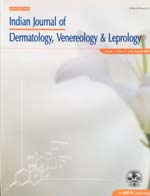
|
Indian Journal of Dermatology, Venereology and Leprology
Medknow Publications on behalf of The Indian Association of Dermatologists, Venereologists and Leprologists (IADVL)
ISSN: 0378-6323
EISSN: 0378-6323
Vol. 76, No. 3, 2010, pp. 249-253
|
 Bioline Code: dv10077
Bioline Code: dv10077
Full paper language: English
Document type: Research Article
Document available free of charge
|
|
|
Indian Journal of Dermatology, Venereology and Leprology, Vol. 76, No. 3, 2010, pp. 249-253
| en |
Irritancy potential of 17 detergents used commonly by the Indian household
Austoria, A. J.; Lakshmi, Chembolli; Srinivas, C. R.; Anand, C. V. & Mathew, A. C.
Abstract
Background: Detergents are used by almost every household in the developed and developing world. Soap and most detergents are anionic surfactants and attack the horny layer of the skin and increase its permeability with little or no inflammatory change and may result in hand eczema, which is very distressing and incapacitating.
Aim: To evaluate the irritant potential of common household detergents (laundry and dish wash) used by the Indian population using a 24-hour patch test and to convincingly educate the patients on the detergents less likely to cause irritation in the particular individual.
Methods: Seventeen commonly used detergents found in Indian market were included in the study, of which, 12 were laundry detergents (powders - seven, bar soap - five) and five were dish wash detergents (powder - one, liquid - one, bar soap - three). The irritant potential of the 17 detergents were evaluated in 30 volunteers. Thirty microliters of each of the detergent bar solutions, distilled water (negative control), and 20% SDS (positive control) were applied to Finn chambers with a micropipette and occluded for 24 hours. Erythema, scaling, and edema were graded in comparison to the reaction at the negative control site (distilled water) for each volunteer separately. The scoring of erythema / dryness and wrinkling on a 0 - 4 point scale and edema on another 0 - 4 point scale was based on the Draize scale. The pH of each of the detergent solutions was determined using litmus papers (Indikrom papers from Qualigens fine chemicals).
Results: The difference between detergents (F value) was significant for erythema / dryness and wrinkling (F = 3.374; p = 0.000), but not significant for edema (F = 1.297; p = 0.194). [Table 2] lists the means for erythema / dryness and wrinkling, and edema. The F value of the totals of the means for erythema / dryness and wrinkling and edema was significant (F = 2.495; p = 0.001). The pH of all the detergents was found to be alkaline except Pril utensil cleaner which tested acidic (pH 6). The positive control, 20% SDS also tested acidic (pH 6).
Conclusion : Similar to patch testing in allergic contact dermatitis, 24-hour patch testing with detergent solutions (8% w/v), will educate the patient on what detergent to avoid. This may bring down the total medication requirement and frequent hospital consultations for these patients.
Keywords
24-hour patch test, detergents, hand eczema, sodium dodecyl sulfate (SDS)
|
| |
© Copyright 2010 Indian Journal of Dermatology, Venereology, and Leprology.
Alternative site location: http://www.ijdvl.com
|
|
